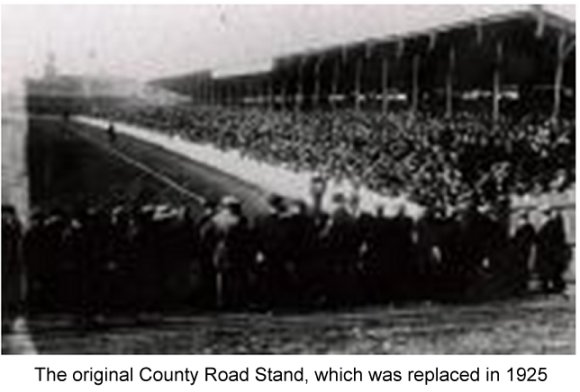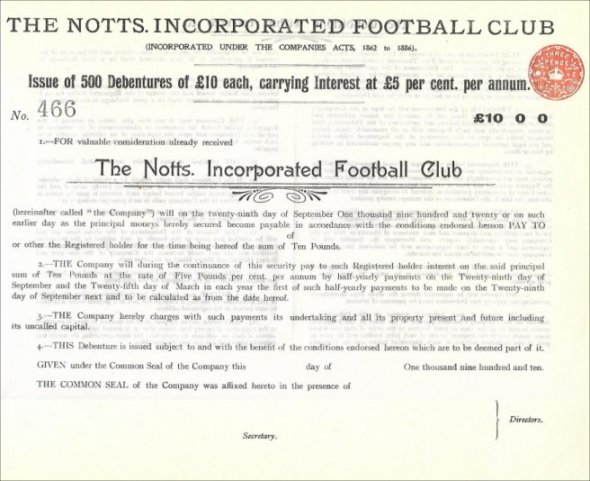There was a detailed description of the new ground in the Nottingham Evening News, which commented that
“in a few months the barren wasteland had been transmogrified”.
Most supporters over thirty can remember the old and antiquated Main Stand. This was the paper’s description of it in 1910.
“The first and the greatest thing to be admired is the grand stand running for 130 feet parallel with Sutton-street, which will seat nearly four thousand. The stand is most substantially built, and is imposing in its proportions and graceful in its lines. The enclosure in front of it, which will be terraced, has been made very deep, and underneath are spacious and comfortable dressing-rooms for the home and visiting teams, the referee and linesmen, suites of rooms for the directors and secretary, and so on. In fact, the whole equipment fulfils all the requirements that management, players, and public have in these advanced times.”
In 1910 County Road did not exist. Here’s the Evening News’ description of the stand that eventually became known as the County Road Stand, which was erected for the “sixpenny spectators.” Interestingly, it states that it was built partly from timber from the stand at Trent Bridge, shown in the picture of the Aston Villa game.
“Running parallel with the gardens that separate the ground from the Cattle Market the “sixpenny spectators” will be housed, and sheltered when need be, under an enlarged and stronger edition of the stands which at Trent Bridge did duty on the Fox-road side. The timber and some of the uprights have been incorporated in the new structure, in front of which is a widish space that is to be terraced.”

Finally, the Nottingham Evening News’ thoughts on the Meadow Lane Stand, which was originally at Trent Bridge cricket ground.
“The ‘big’ stand which has been brought across from Trent Bridge and fixed behind the goal on the Tinker’s Leen side looks quite small beside the new one, but it will serve a very useful purpose and sets off that end better than well. Some improvements are being made, and in future the entrance to the stand will be from the back – a much better arrangement than that which obtained at Trent Bridge.”
To finance the cost of the new ground, the Magpies’ directors decided to issue a series of 500 debentures of £10 each. They paid interest at 5 per cent per annum, paid half-yearly.

The Athletic News of 5th September 1910 described the opening of the Meadow Lane ground.
“With civic ceremony the new ground of the Notts County club was opened on Saturday. The land in Meadow Lane has been secured on lease from the Corporation, and it was a happy thought which prompted the invitations to the members of the City Council to attend the first match. The majority accepted, and the Mayor (Councillor Ball) and the Sheriff (Councillor A. Ward) were amongst those present at the luncheon given by the directors of the club, to meet the president of the League (Mr J. McKenna). Along with Mr. C. E. Sutcliffe and Mr. T. Charnley, representing the Management Committee, members of the Forest club and the Notts Association were also present.
Just before the time fixed for the kick-off the whole party, headed by the Mayor and Sheriff, wearing their chains of office, trooped to the centre of the enclosure, where the Mayor formally declared the ground open. The band played the National Anthem and the crowd cheered heartily. The attendance was worthy of the occasion, for 28,000 people paid for admission, the receipts amounting to £755. These figures easily constitute a record for a League match in the history of the Notts club.”
The game itself ended in a 1-1 draw. Matthews scored for the Magpies after 4 minutes and Forest got the equaliser in the second half.
Only the Boxing Day crowd of 25,000 came anywhere near the attendance for the opening game at the ground and the season’s average was just over 12,500. This must have been disappointing for the directors, as at the AGM on 30th May 1911 they again appealed for better support so that they could compete with wealthier clubs.
The accounts revealed that the cost of equipping the new ground was £7,219. The Balance Sheet showed a Debenture Capital of £3,900, meaning that the £5,000 Debenture issue was nowhere near fully taken up. Apart from the Debentures, which were repayable by 1920, Notts also owed £3,815 to the bank and sundry creditors. In their first season at Meadow Lane the club made a profit of £767 on income of £6,560.
The directors also stated at the AGM that during the past few years they had fostered local talent, and it was their desire to do so with the hope that at some time in the near future they might be represented by a team of local players. Judging by the state of the clubs finances this hope was understandable if not probable, as they couldn’t compete for players against the wealthier clubs in Division 1.
Liverpool finished two places below the Magpies in the league, yet their income was more than double that of Notts. No doubt the directors were hoping to see an improvement in attendances now that the Magpies had a home of their own. However, by the 1914/15 season, the last one before the League was suspended during WW1, the average gate had dropped to 9,000, which was less than the average gate for each of the last 5 seasons at Trent Bridge.
